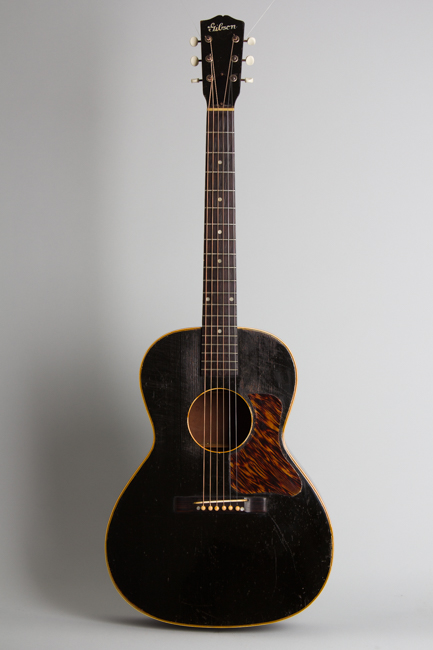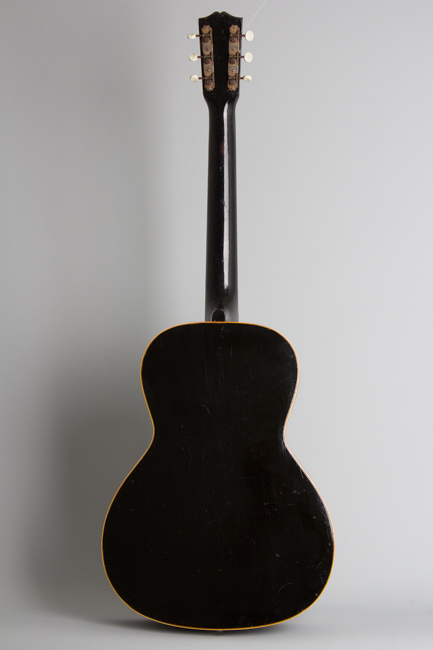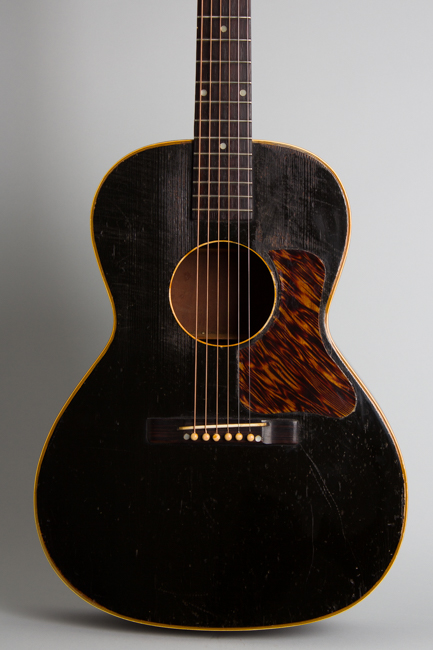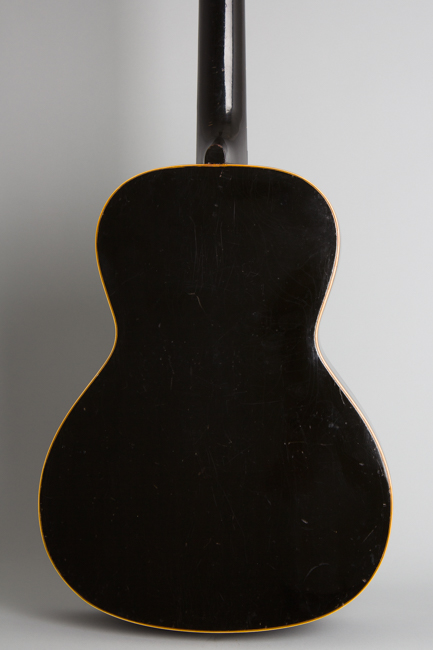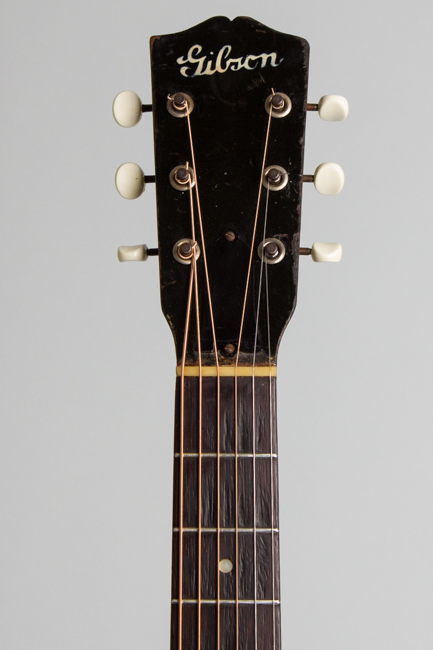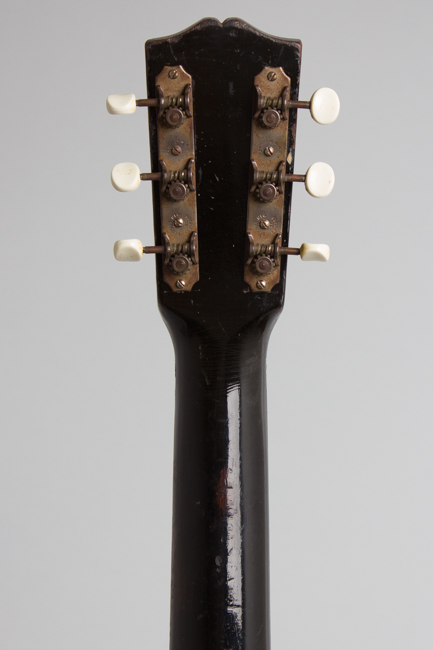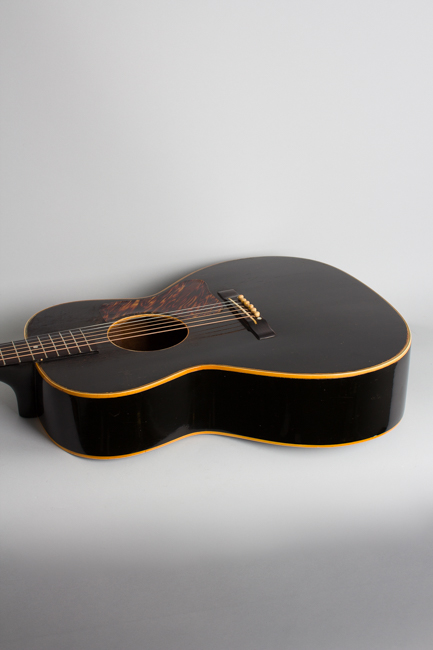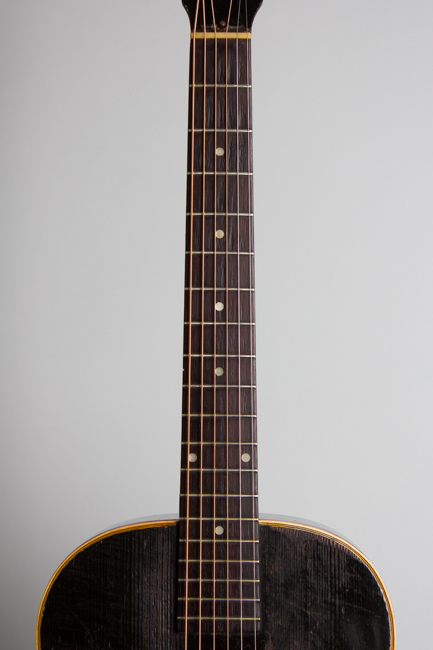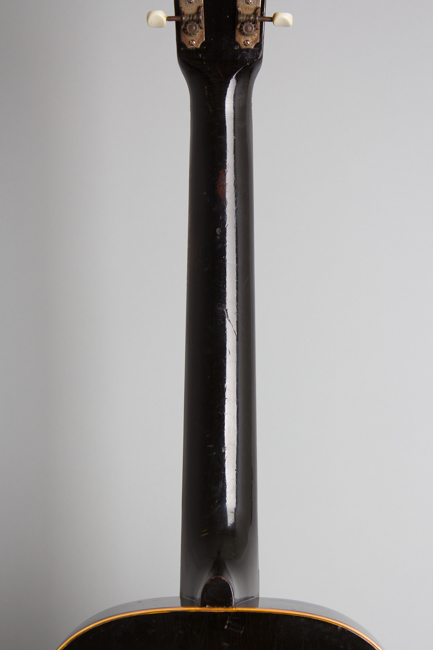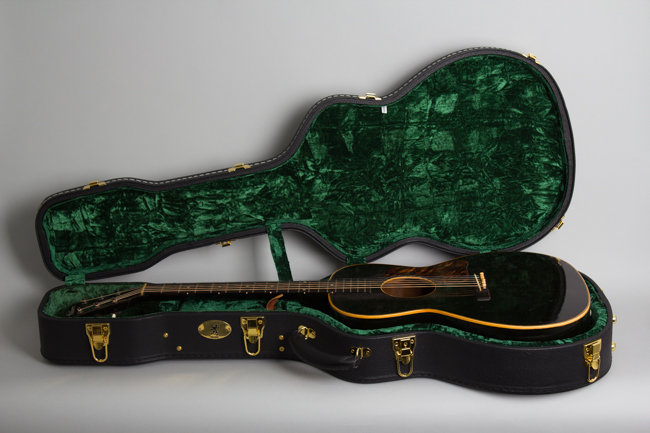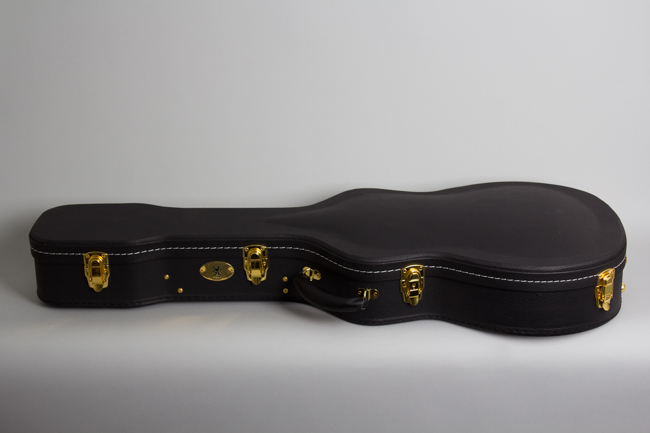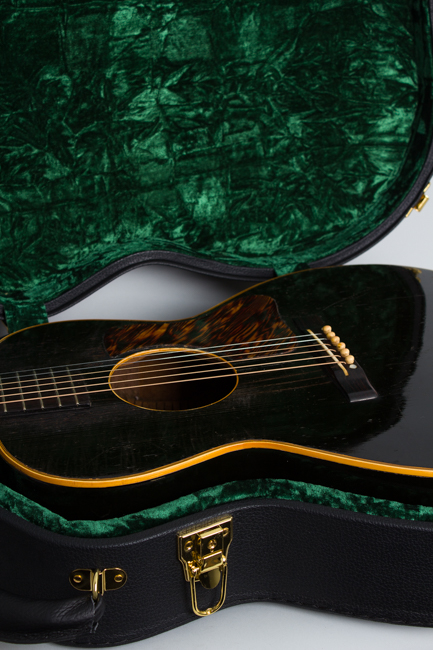Gibson L-0 Flat Top Acoustic Guitar (1942)
This item has been sold.
Item # 10977
Prices subject to change without notice.
Gibson L-0 Model Flat Top Acoustic Guitar (1942), made in Kalamazoo, Michigan, serial # 7427H-1 (FON), black lacquer finish, mahogany back, sides and neck; spruce top, mahogany neck with rosewood fingerboard, black hard shell case.
This is a well-worn but interesting very late production example of Gibson's venerable L-0. It dates to 1942, shortly before the model was discontinued for the second and final time. The wartime period was a difficult one at Gibson, and these 1930's style small-body flat tops were a casualty of the time, replaced by the wider-waisted LG series. Some appear to have been assembled and sold up through 1943, the last of a long line of the budget flat tops that helped Gibson weather the depression.
This guitar has a factory order number (FON) suggesting assembly in mid-late 1942. It sports an overall jet black finish with unusually fancy body binding, 5-ply on the top and 3-ply on the back in place of the standard single strip. In a contrast the soundhole has no rosette and is bound on the edge, like a Kalamazoo. It seems likely that some of these last L-0's were built with components originally made up for other models, including jobber brand instruments. This final model (of which we have seen several examples) was never catalogued with these exact specifications.
The neck is standard for the period, not too chunky with a comfortable round-backed profile much slimmer than the subsequent wartime "Louisville slugger' necks found on many LGs. The Gibson truss rod is still present; many WWII guitars were built without one due to wartime metal restrictions. The headstock has a simple white script Gibson logo and the first wartime open back strip Kluson tuners with full-depth gears riveted to the shafts.
Internally the construction is typical Gibson but somewhat sloppily executed, with a decent amount of glue residue and a somewhat roughly cut-out small maple bridge plate. Accounts from the Gibson factory in WWII indicate many of the newly hired (often female) workers were given only minimal training before being put on the assembly line. Perhaps as a result the inside of this guitar is cruder looking than either earlier or later Gibsons, but everything is solid and appears original. Despite all the wartime difficulties it sounds GREAT with a surprising amount of power and depth and a real shimmer to the tone. This may be a bit of a dark horse in several ways but next to the first 12-fret L-0's from the early 1930s this final example may be our favorite version of this Gibson classic.
Overall length is 40 in. (101.6 cm.), 14 3/4 in. (37.5 cm.) wide at lower bout, and 4 1/4 in. (10.8 cm.) in depth at side, taken at the end block. Scale length is 24 3/4 in. (629 mm.). Width of nut is 1 3/4 in. (44 mm.).
This guitar shows a decent amount of external wear from the last 80 years of use but remains a truly excellent player. The finish is worn overall, most notably the forward areas of the top which have been strummed over quite a bit. There is pickwear into the wood on both sides of the fingerboard and some deeper scratches below and behind the bridge. The finish over the rest of the guitar shows dings, dents and scrapes but the top has borne the brunt of heavy use; there are some minor old touchups in spots. The back of the neck has small dings and dents but no areas worn through the lacquer and none of the deep capo marks often found on flat tops of this era.
The pickguard remains original but has shrunken just a bit and appears to have been reglued more than once. The edges are curling up slightly but it is solid; there is a small piece of the forward tip missing. The area around this guard has seen some finish disturbance and visible touchup. The original rosewood bridge has been lowered somewhat and likely reglued; it shows several tightly repaired cracks on close examination but is completely solid; the original bolts are still intact. Amazingly there are NO other cracks anywhere on the guitar; this may not be the neatest built Gibson we have seen but it is very solid.
The neck has been reset and the frets appear original, crowned down somewhat but still quite playable with some light subsequent wear. The nut appears later and there is a decent amount of finish finagle in front of it. The tuners are original; modern repros were on for a time but left little trace and these restored work fine. This is a very vibey but superb sounding "natural relic" instrument, a real player's Gibson flat top with a lot of stories and songs still in it. Overall Very Good + Condition.
This is a well-worn but interesting very late production example of Gibson's venerable L-0. It dates to 1942, shortly before the model was discontinued for the second and final time. The wartime period was a difficult one at Gibson, and these 1930's style small-body flat tops were a casualty of the time, replaced by the wider-waisted LG series. Some appear to have been assembled and sold up through 1943, the last of a long line of the budget flat tops that helped Gibson weather the depression.
This guitar has a factory order number (FON) suggesting assembly in mid-late 1942. It sports an overall jet black finish with unusually fancy body binding, 5-ply on the top and 3-ply on the back in place of the standard single strip. In a contrast the soundhole has no rosette and is bound on the edge, like a Kalamazoo. It seems likely that some of these last L-0's were built with components originally made up for other models, including jobber brand instruments. This final model (of which we have seen several examples) was never catalogued with these exact specifications.
The neck is standard for the period, not too chunky with a comfortable round-backed profile much slimmer than the subsequent wartime "Louisville slugger' necks found on many LGs. The Gibson truss rod is still present; many WWII guitars were built without one due to wartime metal restrictions. The headstock has a simple white script Gibson logo and the first wartime open back strip Kluson tuners with full-depth gears riveted to the shafts.
Internally the construction is typical Gibson but somewhat sloppily executed, with a decent amount of glue residue and a somewhat roughly cut-out small maple bridge plate. Accounts from the Gibson factory in WWII indicate many of the newly hired (often female) workers were given only minimal training before being put on the assembly line. Perhaps as a result the inside of this guitar is cruder looking than either earlier or later Gibsons, but everything is solid and appears original. Despite all the wartime difficulties it sounds GREAT with a surprising amount of power and depth and a real shimmer to the tone. This may be a bit of a dark horse in several ways but next to the first 12-fret L-0's from the early 1930s this final example may be our favorite version of this Gibson classic.
Overall length is 40 in. (101.6 cm.), 14 3/4 in. (37.5 cm.) wide at lower bout, and 4 1/4 in. (10.8 cm.) in depth at side, taken at the end block. Scale length is 24 3/4 in. (629 mm.). Width of nut is 1 3/4 in. (44 mm.).
This guitar shows a decent amount of external wear from the last 80 years of use but remains a truly excellent player. The finish is worn overall, most notably the forward areas of the top which have been strummed over quite a bit. There is pickwear into the wood on both sides of the fingerboard and some deeper scratches below and behind the bridge. The finish over the rest of the guitar shows dings, dents and scrapes but the top has borne the brunt of heavy use; there are some minor old touchups in spots. The back of the neck has small dings and dents but no areas worn through the lacquer and none of the deep capo marks often found on flat tops of this era.
The pickguard remains original but has shrunken just a bit and appears to have been reglued more than once. The edges are curling up slightly but it is solid; there is a small piece of the forward tip missing. The area around this guard has seen some finish disturbance and visible touchup. The original rosewood bridge has been lowered somewhat and likely reglued; it shows several tightly repaired cracks on close examination but is completely solid; the original bolts are still intact. Amazingly there are NO other cracks anywhere on the guitar; this may not be the neatest built Gibson we have seen but it is very solid.
The neck has been reset and the frets appear original, crowned down somewhat but still quite playable with some light subsequent wear. The nut appears later and there is a decent amount of finish finagle in front of it. The tuners are original; modern repros were on for a time but left little trace and these restored work fine. This is a very vibey but superb sounding "natural relic" instrument, a real player's Gibson flat top with a lot of stories and songs still in it. Overall Very Good + Condition.
